
Brussels Park is the largest urban public park in central Brussels, Belgium. Formerly known and still sometimes colloquially referred to as the Royal Park, it was the city's first public park, being originally laid out between 1776 and 1783 in a neoclassical style by the French architect Gilles-Barnabé Guimard and the Austrian landscape architect Joachim Zinner, as part of an urban project including the Place Royale/Koningsplein. The area of the rectangular park is 13.1 ha.

The Royal Saint-Hubert Galleries is an ensemble of three glazed shopping arcades in central Brussels, Belgium. It consists of the King's Gallery, the Queen's Gallery and the Princes' Gallery.

The Brussels Stock Exchange, abbreviated to BSE, was founded in Brussels, Belgium, by decree of Napoleon in 1801. In 2002, the BSE merged with the Amsterdam, Lisbon and Paris stock exchanges into Euronext, renaming the BSE Euronext Brussels. The most well known stock market index on the BSE is the BEL20.
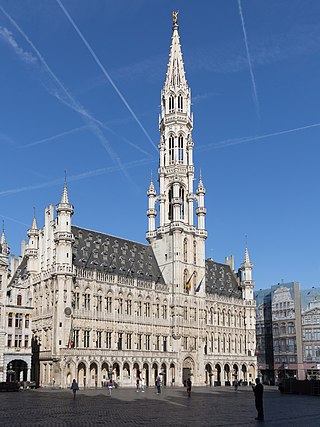
The Town Hall of the City of Brussels is a landmark building and the seat of that municipality of Brussels, Belgium. It is located on the south side of the Grand-Place/Grote Markt, opposite the neo-Gothic King's House or Bread House building, housing the Brussels City Museum.
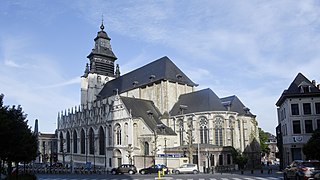
The Church of Our Lady of the Chapel, or the Chapel Church, is a Catholic church in the Marolles/Marollen district of Brussels, Belgium. It is dedicated to Our Lady of the Chapel.
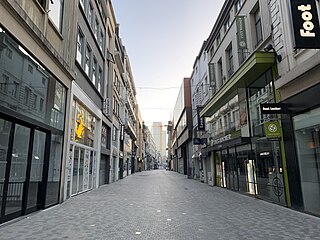
The Rue Neuve or Nieuwstraat, meaning "New Street", is a pedestrian street in central Brussels, Belgium. It runs between the Place de la Monnaie/Muntplein and the Rue du Fossé aux Loups/Wolvengracht to the south and the Place Charles Rogier/Karel Rogierplein and the Boulevard du Jardin botanique/Kruidtuinlaan to the north.

The Church of St. James on Coudenberg is a Catholic church on the historic Place Royale/Koningsplein, in the Royal Quarter of Brussels, Belgium. It is dedicated to Saint James, one of the Twelve Apostles of Jesus.

The Place des Martyrs or Martelaarsplein, meaning "Martyrs' Square", is a historic square in central Brussels, Belgium. Its current name refers to the martyrs of the September Days of the Belgian Revolution of 1830.

The Church of St. John the Baptist at the Béguinage is a Catholic parish church in central Brussels, Belgium. It is dedicated to Saint John the Baptist.
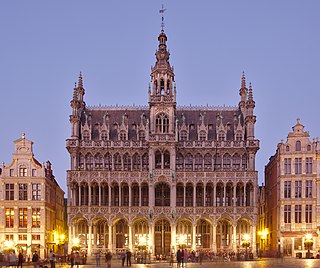
The Brussels City Museum is a municipal museum on the Grand-Place/Grote Markt of Brussels, Belgium. Conceived in 1860 and inaugurated in 1887, it is dedicated to the history and folklore of the City of Brussels from its foundation into modern times, which it presents through paintings, sculptures, tapestries, engravings, photos and models, including a notable scale-representation of the town during the Middle Ages.
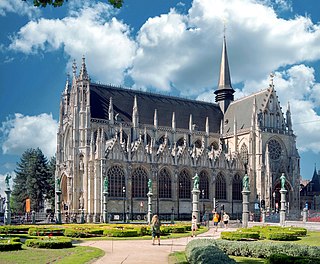
The Sablon or Zavel is a neighbourhood and hill in the historic upper town of Brussels, Belgium. At its heart are twin squares: the larger Grand Sablon or Grote Zavel square in the north-west and the smaller Petit Sablon or Kleine Zavel square and garden in the south-east, divided by the Church of Our Lady of Victories at the Sablon and the Rue de la Régence/Regentschapstraat. This area is served by Brussels-Chapel railway station and Brussels-Central railway station, as well as the tram stop Petit Sablon/Kleine Zavel.

The Place de Brouckère or De Brouckèreplein (Dutch) is a major square in central Brussels, Belgium. It was created following the covering of the river Senne (1867–1871), replacing the Temple of the Augustinians, which was demolished in 1893. It is named in honour of Charles de Brouckère, a former mayor of the City of Brussels and professor at the Free University of Brussels, who played a great political role during the Belgian Revolution of 1830. The square measures approximately 50 by 350 metres and is nearly entirely paved.

The Boulevard Adolphe Max or Adolphe Maxlaan (Dutch) is a central boulevard in Brussels, Belgium. It was created following the covering of the river Senne (1867–1871), and bears the name of Adolphe Max, a former mayor of the City of Brussels.

The Place Rouppe (French) or Rouppeplein (Dutch) is a square in central Brussels, Belgium. It is named in honour of Nicolas-Jean Rouppe, the first mayor of the City of Brussels following the Belgian Revolution of 1830. Rectangular and symmetrical in shape, it is located in the Midi–Lemonnier or Stalingrad Quarter, between the Rue du Midi/Zuidstraat and the Avenue de Stalingrad/Stalingradlaan.
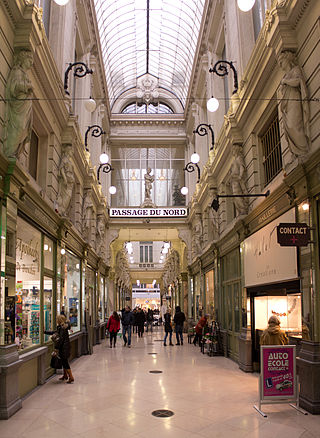
The Northern Gallery or Northern Passage is a glazed shopping arcade in central Brussels, Belgium. It was built in 1881–82 in an eclectic style by Henri Rieck, following the covering of the Senne and the creation of the Central Boulevards. It is decorated with 32 caryatids in the neoclassical style by Jean-François-Joseph Bertheux and sculptures and putti by Constant Albert Desenfants.
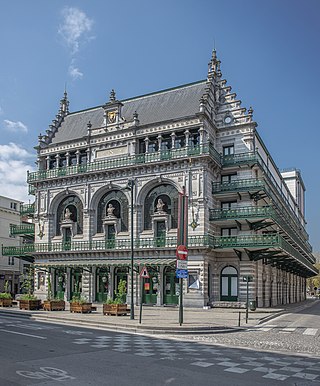
The Royal Flemish Theatre is a theatre in central Brussels, Belgium. It is the anchor of the Flemish theatre company in Brussels, which aims to promote professional theatre in the Dutch language in Belgium and abroad. A place is also made for dance, poetry, music and temporary exhibitions.
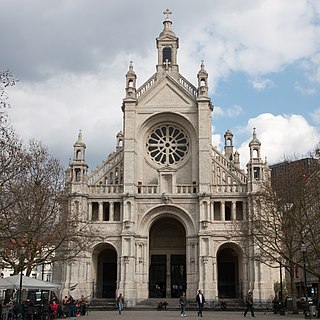
The Church of St. Catherine is a Catholic parish church in Brussels, Belgium. It is dedicated to Saint Catherine.

The Boulevard Émile Jacqmain (French) or Émile Jacqmainlaan (Dutch) is a central boulevard in Brussels, Belgium. It was created following the covering of the river Senne (1867–1871), and bears the name of Émile Jacqmain, a former Alderman for Public Education.

The Church of St. Nicholas is a Catholic church in central Brussels, Belgium. Founded around 1125, it is one of the first four churches in Brussels and the best preserved in its successive developments. It is dedicated to Saint Nicholas.
























